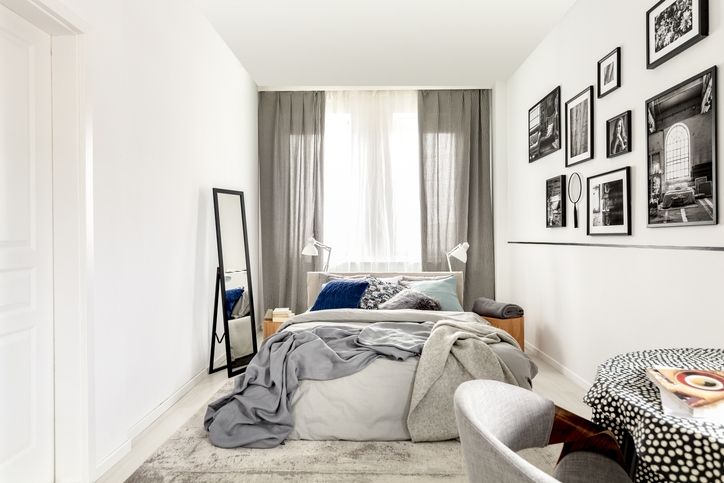Your home is the perfect space to relax, unwind, and be yourself. Beautiful decor, lighting, and some personal touches can significantly change your room’s appearance. Yet despite these nuances, your room may feel cramped or spacious. A fantastic way to make a room look bigger or smaller is by painting it with colors other than the ones already on your walls.
Color has the unique ability to transform not just a room’s aesthetic appeal but also its perceived shape, size, and ambiance. With the right selection, you can set the ideal color scheme for your space. This article guides you to some colors that will make your room appear to be a different size than it actually is.
The Rule of Thumb when Using Colors in a Room
The rule of thumb is that lighter and cooler colors lend a receding effect in a room, meaning they appear farther away, especially when natural daylight fills the space. Darker colors, on the other hand, tend to advance and appear towards us.
This concept may be used to make a room look larger or smaller, whether with patterns or none. Applying a specific color in a room can fool our eyes into seeing that a room is big or small. This concept can also change the space by bringing out your room’s positive aspects and hiding the not-so-attractive ones.
Debunking Color Myths
However, the rule of thumb mentioned earlier may not apply correctly to every situation. Do dark colors really make a room feel smaller? This section debunks that myth and other misconceptions about color perceptions in a room.
Myth 1: Dark colors make a room feel smaller
While dark colors can absorb light and potentially make a room feel cozier, they don’t necessarily make it feel smaller. With proper lighting and strategic use of mirrors, dark colors can add depth and sophistication without shrinking the space.
Myth 2: White always makes a room feel bigger
While white can make a space feel airier and more open, it’s not the only option for creating a sense of spaciousness. Light neutrals, pastels, and even some darker shades, when paired with good lighting and minimalistic decor, can also enhance a room’s perceived size.
Myth 3: You can’t use bold colors in small rooms
Bold colors can actually add personality and warmth to small spaces. When used thoughtfully, bold colors create a dramatic and inviting atmosphere without overwhelming the room.
Myth 4: Ceilings should always be white
While white ceilings can make a room feel taller, using a color on the ceiling can add character and cohesion to the overall design. Light shades or even darker colors can work well, depending on the desired effect and room height.
Myth 5: You must stick to one color scheme throughout the house
It’s a myth that every room needs to follow the same color scheme. Different rooms can have distinct color palettes that reflect their unique functions and moods, creating a dynamic and appealing home.
Myth 6: Neutral colors are boring
Neutral colors can be incredibly versatile and sophisticated. They provide a calming backdrop that can be enhanced with colorful accents and textures, allowing for flexibility in design and decor.
Myth 7: Bright colors are too overwhelming for interiors
Bright colors can be invigorating when used appropriately. Balancing bright hues with neutrals or using them as accents can create a lively and energetic environment without being overpowering.
Myth 8: Patterns make a room look cluttered
Patterns can add depth and interest to a room when used in moderation. The key is to balance patterns with solid colors and ensure the patterns complement the overall design aesthetic.
Myth 9: Cool colors are only for modern spaces
Cool colors like blues and greens can work beautifully in various styles, from traditional to contemporary. The context and complementary elements in the room determine how a color is perceived.
Myth 10: Warm colors make a room feel smaller
Warm colors can make a space feel cozy and inviting without making it feel smaller. The effect of color depends on the room’s lighting, layout, and how the color integrates with the decor.
Understanding these myths can help you make more informed decisions about color choices in your home, leading to a space that truly reflects your style and preferences.
Non-Painting Tips to Make a Room Feel Bigger or Smaller
The following tips can help you manipulate the perception of space in a room without relying on paint, creating a more expansive or intimate atmosphere as desired.
To make a room feel bigger:
- Maximize natural light: Open curtains or blinds to let in as much natural light as possible. Use sheer curtains to diffuse light without blocking it.
- Use mirrors: Place mirrors strategically to reflect light and create the illusion of more space. A large mirror on one wall can make a room feel significantly more spacious.
- Declutter: Keep the room tidy and organized. Minimal furniture and decor can make the space feel airier and more open.
- Furniture arrangement: Arrange furniture to enhance flow and openness. Keep pathways clear and avoid blocking windows or doorways.
- Multi-functional furniture: Use furniture that can serve multiple purposes, such as ottomans with storage, foldable tables, or sofa beds.
- Raised furniture: Choose furniture with legs that raise it off the floor, creating a sense of more floor space.
- Vertical storage: Use shelves and storage solutions that make use of vertical space, drawing the eye upward and freeing up floor space.
- Large fugs: Use a large area rug to anchor the room and create the illusion of a larger floor area.
- Transparent furniture: Choose glass or acrylic furniture with less visual space.
- Wall-mounted storage: Utilize shelves and cabinets to keep the floor space open.
To make a room feel smaller:
- Cozy furniture arrangement: Arrange furniture in a way that creates intimate and comfortable spaces. Grouping furniture can make the room feel more contained.
- Layer textures and fabrics: Use rich textures and layered fabrics, like plush rugs, heavy curtains, and cozy blankets, to create warmth and coziness.
- Add drapes: Use heavy, floor-length drapes to create a snug and inviting atmosphere.
- Use room dividers: Incorporate room dividers, such as screens or bookcases, to break up the space and create a more intimate environment.
- Warm lighting: Use warm-toned lighting to create a cozy ambiance. Lamps and soft lighting can make the room feel more intimate.
- Oversized furniture: Choose larger, more substantial furniture that fills the space, making it feel cozier.
- Decorative accessories: Add plenty of decorative accessories like cushions, throws, and artwork to fill the space and make it feel more enclosed.
- Lower ceilings: Use ceiling treatments or beams to make the ceiling feel lower, creating a more intimate feel.
- Dark window treatments: Install dark curtains or shades to make the room feel cozier and more enclosed.
- Rugs and carpets: Use smaller, more layered rugs to create distinct, cozy areas within the room.
Conclusion
Color’s impact on interior design is undeniable – it can influence an interior space’s look, mood, perception, and functionality. Understanding color’s emotional impact is crucial as it can guide you to create your room’s desired look and atmosphere.
Transform your space and bring your vision to life with the perfect color palette! Contact Custom Painting, Inc. today for expert color consultation, personalized recommendations, and professional paint service. Don’t settle for ordinary—let’s create a home you’ll love. Call Custom Painting, Inc. at 925-294-8062, or use our contact form and start your journey to a beautifully designed interior!


